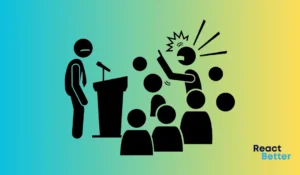I know you’ve been there. You’re at work, trying to get something done, and you ask a coworker for help. But instead of pitching in, they hit you with the dreaded That’s not my job line. It’s frustrating, right? Whether you’re dealing with a slacker colleague or navigating tricky workplace dynamics, knowing how to respond can make all the difference.
I’ve faced this situation more times than I can count, and I’ve learned that the right reply can turn things around. Sometimes, a touch of humor diffuses tension. Other times, a firm but professional approach is key. And occasionally, you need to get creative to find a win-win solution.
Here, I’m sharing 75+ ways to respond to that’s not my job. I’ve broken them down into different approaches, so you’ll have the perfect comeback no matter the situation. Plus, I’ll throw in some real-world examples to show these strategies in action.
By the end, you’ll be ready to tackle workplace resistance like a pro.
Table of Contents
1. The Collaborative Approach
When faced with the That’s not my job response, sometimes the best strategy is to emphasize teamwork and mutual benefit. Here are some ways to do that:
1. I understand it’s not officially your responsibility, but I’d really appreciate your help. Is there anything I can assist you with in return?
2. Let’s think about how we can tackle this together. Your expertise would be invaluable here.
3. I know it’s outside your usual tasks, but your input could really make a difference. How about we brainstorm a solution?
4. You’re right, it’s not in your job description. But neither of us wants this project to fail. Can we find a way to make it work?
5. I respect your boundaries, but this issue affects the whole team. How can we address it collaboratively?
6. Your skills would be perfect for this. Could we look at redistributing some tasks so you can help out?
7. I’m struggling with this part. Could you show me how you’d approach it, even if you can’t do it yourself?
8. What if we treated this as a learning opportunity for both of us? I’d love to understand your perspective on the problem.
9. I know you’re busy with your own work. Could we set aside 15 minutes to discuss how we might tackle this together?
10. Your experience would be really helpful here. Could you act as a consultant on this, even if you can’t do the actual work?
11. I’m trying to improve our workflow. Your insights could be crucial. Would you be willing to share your thoughts?
12. This task is proving trickier than expected. Could we pool our skills to find a solution?
13. I respect that it’s not your usual role, but our team’s success depends on flexibility. How can we make this work for everyone?
14. Your unique skills could really elevate this project. Could we explore ways to involve you without overstepping boundaries?
15. I know it’s not your job, but your perspective could be game-changing. Would you consider being a sounding board?
16. Let’s look at this from a team perspective. How can we distribute tasks to play to everyone’s strengths?
17. I value your expertise. Even if you can’t do the task, could you guide me through the process?
18. This situation highlights a gap in our workflow. Could we work together to find a long-term solution?
19. Your input could save us time and resources in the long run. How about a quick brainstorming session?
20. I understand your hesitation, but this could be a chance to showcase your versatility. What do you think?
Also Read: Effective Strategies to Get Your Voice Heard in Meetings without Being Rude
Real-world example: At a tech startup, a developer was asked to help with customer support during a product launch. Initially, he responded with That’s not my job. The project manager replied-
“I know it’s outside your usual role, but your technical knowledge would be invaluable in explaining features to customers. Plus, this experience could give you insights for future development work. How about we set up a rotation so it doesn’t impact your main tasks too much?”
This collaborative approach led to the developer agreeing to help for a few hours each week, which significantly improved customer satisfaction and provided valuable user feedback for future updates.
2. The Professional and Assertive Approach

Sometimes, a more direct and professional approach is necessary, especially in formal work environments or when dealing with persistent issues. Here’s how to assert yourself while maintaining professionalism:
21. I understand this isn’t typically your responsibility, but the current situation requires all hands on deck. How can we make this work?
22. Our team’s success depends on flexibility. Can we discuss how to integrate this task into your workflow?
23. I’ve noticed this issue coming up repeatedly. Let’s schedule a meeting to clarify roles and responsibilities.
24. While it may not be in your job description, adapting to new challenges is part of our company culture. How can I support you in taking this on?
25. I respect your position, but this task is crucial for our project’s success. Can we explore solutions together?
26. Let’s review our team’s objectives. This task aligns with our goals, and your skills are well-suited for it.
27. I appreciate your honesty about your role. However, we need to find a solution. What alternatives do you suggest?
28. Our team is evolving, and so are our responsibilities. Can we discuss how to integrate new tasks effectively?
29. I understand your concern, but refusing tasks can impact team morale. How can we address this constructively?
30. This situation highlights a need for cross-training. Would you be open to expanding your skillset?
31. Your expertise is valuable here. Can we look at reallocating some of your current tasks to make room for this?
32. I hear your hesitation. Let’s discuss this with our supervisor to find the best way forward.
33. Our client/deadline/project requires us to be adaptable. How can we work together to meet this challenge?
34. I respect your boundaries, but we need to find a solution. Can you recommend someone else who might be able to help?
35. This task falls into a grey area of responsibility. Let’s clarify our roles to prevent future misunderstandings.
36. I understand it’s not your typical duty, but it’s crucial for our team’s success. How can we make it feasible for you?
37. Your skills are uniquely suited for this task. Can we discuss how to incorporate it into your workload?
38. This situation reveals a gap in our process. Can we work together to propose a long-term solution to management?
39. I appreciate your candor. However, we need to address this task. What resources would you need to take it on?
40. Let’s look at this from a career development perspective. How could this task enhance your skills and visibility?
Real-world example: In a marketing agency, a graphic designer consistently refused to help with basic web updates, saying,
“That’s not my job. The project manager addressed it by saying, I understand web updates aren’t typically in your role, but our team needs to be versatile to meet client demands. Let’s schedule a meeting to review your current workload and see how we can integrate these tasks without overwhelming you. This could also be an opportunity to expand your skill set, which could lead to more diverse projects in the future.”
This professional yet assertive approach led to a productive discussion about workload balance and skill development, ultimately resolving the issue.
3. The Humorous and Light-hearted Approach
Sometimes, a bit of humor can defuse tension and open up a more positive dialogue. Here are some light-hearted ways to respond to that’s not my job:
41. Oh, I must have missed the memo where we all became super-specialized robots. Last I checked, we were a team of humans helping each other out!
42. Not your job? And here I thought your job title was ‘Superhero in Disguise, Ready to Save the Day’!
43. You’re right, it’s not your job. It’s your chance to be the office hero! Cape optional, but highly recommended.
44. I didn’t realize we had a ‘Department of That’s Not My Job’. Is there a suggestion box I can drop this task into?
45. Ah, I see you’ve mastered the ancient art of task-dodging. Care to teach me your ways, oh wise one?
46. Not your job? Funny, I don’t remember seeing ‘Only Do Things Explicitly Written in Job Description’ in the company values.
47. Oh no, my ‘Get Someone Else to Do It’ spell must have backfired! Any chance you know the counterspell?
48. I must have missed the ‘Mind Your Own Business’ seminar. Was there a handout I can borrow?
49. Wow, your job description must be written in invisible ink. Mind if I borrow those special glasses to read it?
50. Not your job? And here I thought we were playing ‘Office Job Roulette’ today!
51. I didn’t realize we had a strict ‘No Helping Colleagues’ policy. Should we put that in the employee handbook?
52. Oh, I’m sorry, I thought your job title was ‘Awesome Coworker Who Occasionally Helps Out’. My mistake!
53. Not your job? Darn, I must have dialed the wrong extension on the Bat-phone. Is there a Commissioner Gordon around?
54. I see you’ve activated your ‘Task Force Field’. Any chance you have a secret off switch?
55. Ah, you must be saving your energy for the upcoming ‘Office Olympics: Task Avoidance Edition’. Carry on, champ!
4. The Solution-Oriented Approach
When faced with resistance, focusing on problem-solving can be an effective strategy. Here are some ways to steer the conversation towards finding solutions:
56. I see this task doesn’t fit your current role. Can we brainstorm ways to address this gap in our workflow?
57. You’re right, it’s not officially your job. But since you’re familiar with the issue, what solution would you propose?
58. This situation highlights a need in our team. How do you think we should handle similar cases in the future?
59. I understand your hesitation. Can we look at this as a problem-solving exercise? Your insight would be valuable.
60. Let’s take a step back and look at the bigger picture. How can we ensure tasks like these are handled efficiently?
61. Your expertise could really help here. Even if you can’t do the task, could you guide me on how to approach it?
62. This seems to be a recurring issue. Could we work on creating a process to handle these situations better?
63. I appreciate you pointing this out. It shows we need to clarify our roles. Can we discuss how to improve our task allocation?
64. You’re in a unique position to see the gaps in our workflow. What changes would you suggest to prevent this issue?
65. This task doesn’t fit neatly into anyone’s job description. How about we propose a solution to management together?
66. I value your perspective on this. Even if you can’t take it on, could you help me identify the right person or approach?
67. This situation presents an opportunity to improve our team’s efficiency. What ideas do you have to address it?
68. You’re right to question this. Let’s use this moment to review our processes and see where we can make improvements.
69. I understand it’s not your responsibility, but your experience is relevant. Could you mentor someone else to handle this?
70. This task falls into a grey area. Can we work together to define a clear process for handling similar situations?
71. Your input could be crucial in solving this. Even if you can’t do the task, would you be willing to consult on it?
72. I see this as a chance to innovate our workflow. What ideas do you have for addressing these kinds of tasks efficiently?
73. You’ve identified a gap in our current system. How do you think we should adapt to handle these situations better?
74. This is clearly a pain point in our process. Can we collaborate on finding a long-term solution?
75. Your reluctance shows we need to reassess our task distribution. Would you help me draft a proposal for a better system?
Real World Example: At a major company, an IT pro kept dodging basic tech help, always claiming it wasn’t his job. The department boss took a smart approach:
“I get it’s not your main gig, but let’s use this chance to make things better. Can you help create a system to handle these tasks without messing up your work? Your know-how would be key.”
This clever move not only fixed the problem but got the IT guy involved in building a better way to handle tech support company-wide.
Wrapping Up!
Handling the “That’s not my job” response requires a mix of tact, creativity, and problem-solving skills. Remember, the goal is not just to get the immediate task done, but to foster a more collaborative and efficient work environment.
By approaching these situations with empathy, professionalism, and a focus on solutions, you can turn potential conflicts into opportunities for growth and improved teamwork. Stay flexible, keep communication open, and don’t be afraid to think outside the box.
With these strategies in your toolkit, you’re well-equipped to navigate workplace challenges and build stronger, more cooperative relationships with your colleagues.
Common Questions Asked
Q1: What if the person persistently refuses to help, even after trying these approaches?
If the issue persists, it may be time to involve a supervisor or HR. Document the instances and your attempts to resolve the situation professionally.
Q2: How can I prevent the That’s not my job attitude from spreading in my team?
Foster a culture of collaboration and flexibility. Regularly discuss and clarify roles, recognize team members who go above and beyond, and lead by example.
Q3: Is it ever okay to say That’s not my job?
While it’s generally better to find more constructive ways to express concerns, there may be times when it’s appropriate to clarify role boundaries, especially if a task poses legal or ethical issues.
Q4: How can I balance being helpful with not taking on too much additional work?
It’s important to maintain clear communication about your workload and capacity. Offer to help where you can, but also be honest about your limitations and suggest alternative solutions when necessary.
Q5: What if I’m the one always being asked to do tasks outside my job description?
If you find yourself consistently taking on extra tasks, it may be time for a conversation with your supervisor about your role, workload, and potential for role expansion or promotion.
- 25 Top Valentine’s Day Quotes for Friends 2025 - February 12, 2025
- 91 Replies to Respond to Congratulations – For Every Occasion! - February 6, 2025
- 100 Funny Responses To Late Replies In Texting - February 3, 2025





